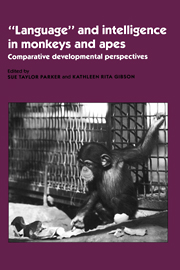Book contents
- Frontmatter
- Contents
- List of contributors
- Foreword
- Preface
- Acknowledgments
- Part I Theoretical frameworks for comparative developmental studies
- Part II Comparative developmental perspectives on cebus intelligence
- Part III Questions regarding imitation, “language,” and cultural transmission in apes and monkeys
- 9 Do monkeys ape?
- 10 Cultural transmission in the tool use and communicatory signaling of chimpanzees?
- 11 Primate cognition: From representation to language
- Part IV Developmental perspectives on social intelligence and communication in great apes
- Part V Development of numerical and classificatory abilities in chimpanzees and other vertebrates
- Part VI Comparative developmental perspectives on ape “language”
- Index
9 - Do monkeys ape?
Published online by Cambridge University Press: 11 May 2010
- Frontmatter
- Contents
- List of contributors
- Foreword
- Preface
- Acknowledgments
- Part I Theoretical frameworks for comparative developmental studies
- Part II Comparative developmental perspectives on cebus intelligence
- Part III Questions regarding imitation, “language,” and cultural transmission in apes and monkeys
- 9 Do monkeys ape?
- 10 Cultural transmission in the tool use and communicatory signaling of chimpanzees?
- 11 Primate cognition: From representation to language
- Part IV Developmental perspectives on social intelligence and communication in great apes
- Part V Development of numerical and classificatory abilities in chimpanzees and other vertebrates
- Part VI Comparative developmental perspectives on ape “language”
- Index
Summary
It is proverbial that monkeys carry the principle of imitation … they are animals that imitate for the mere sake of imitating.
– Romanes (1884, p. 477)Scimmiottare in Italian, singer in French, macaquear in Portuguese, nachäffen in German, majmuna in Bulgarian, obez'janstvovat' in Russian, majmol in Hungarian, matpowac' in Polish, and “to ape” in English – each of these verbs is derived from a linguistic root that in that particular language labels primates. Across different languages and cultures, these verbs consistently mean “to imitate.” The convergence across different cultures of the terms denoting monkeys and imitation reflects the common view that monkeys are excellent imitators. It is quite true that nonhuman and human primates share basic features of anatomy and movement. Because of their physical similarities to humans, nonhuman primates are the best candidates to perform actions resembling our own, and this may encourage the idea that they copy us. But are primates really proficient imitators?
The functional value of imitation as a means of producing similar behaviors among members of a group has been emphasized by many (e.g., Davis, 1973; Hauser, 1988; Meltzoff & Moore, 1983). Imitation is particularly useful as a means of learning from others when the observer is not proficient, when opportunities for practice are limited, when the costs of errors are high, and when learning by individual experience would be a slow process.
- Type
- Chapter
- Information
- 'Language' and Intelligence in Monkeys and ApesComparative Developmental Perspectives, pp. 247 - 273Publisher: Cambridge University PressPrint publication year: 1990
- 100
- Cited by



